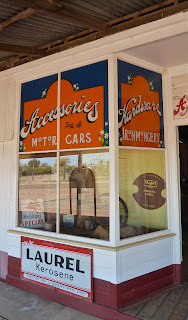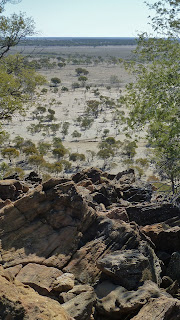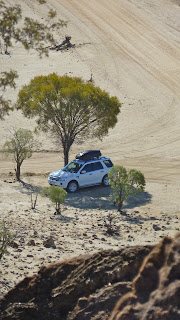| The fence beyond which we could not go |
We'd been lulled into a false sense of security by the first few kilometres: beyond Mt Walker the bitumen stopped, which was indicated on the map but I hadn't paid attention. Perhaps there comes a time when you tire of gravel. And we had 435 kilometres to go, plus I was on a mission. There were a few of these birds on the road, dashing about after insects, as the country became emptier of vegetation, and life generally. There was a new design of station sign I liked, indicating which breed of cattle they stock.
| Australian Pratincole – a first! |
| Grass plains nothingness |
 |
| Flinders Poppies |
Fortunately, we came across this guy at a sealed floodway section, possibly Landsborough Creek channels. We pulled right off to the left and let him pass – all the better to photograph.
It was almost midday, and time for roos to seek shade.
Muttaburra, 204 kilometres from Hughenden, was an interesting little place, and quite lively. Just to the north of the town, the Landsborough, Towerhill and Cornish (Torrens) Creeks come together to form the Thomson River, the river at Longreach. This is many-channelled country, but at this time of year, and in drought, they were indistinguishable from any other patch of parched earth. (Also north of Muttaburra – 17 km to be precise – is the geographical centre of Queensland.) There must have been water somewhere, because a variety of birdlife was evident before we were properly in town. I had never been able to get so close to beautiful Brolgas before.
Galahs and Little Corellas were sharing a tree: I'm not sure the latter were that keen on the idea. They were mumbling under their breath, not their usual squeaky chatter at all. We also saw Lapwings, and fighting Magpies, which is unusual. Later, back on the road, we disturbed a group of Galahs and Apostlebirds, and there were Black Kites circling, which has come to mean Outback to me as much as red dirt and Spinifex.
 |
| Tweedle-dum and Tweedle-dee |
Muttaburra used to have one of those we-have-everything shops that were once found in most Outback towns. The history of Cassimatis General Store began in 1914 when a Greek family arrived in town and rented a small cafe. The business they built up traded for 60 years, until 1978: the store is now a fascinating museum and includes the family's cottage next door.
The previous evening, over our gloopy Chinese in Hughenden, we'd had more choices to make: not to visit Aramac and Horsetailers Gorge (we were a tad over-Gorged); and to reinstate Starlights Lookout, somewhere north of Longreach. The latter had been on last year's itinerary, on day 2, but that was before a puncture on a Sunday stole the time away that day. I found out about the Lookout back on our first Outback trip, but we'd never been to Longreach before and there was a lot to explore in the town itself.
The story associated with Starlights Lookout is a great yarn. It concerns Harry Readford, a stockman and bushranger who became notorious as a cattle-duffer: that's cattle thief in English. In 1870, he worked on a vast station south of Longreach, Bowen Downs, and he hatched a plan to gradually 'disappear' and hoard away some of the cattle in a remote area of the property. When he had gathered about 1000, he and a couple of partners in crime spirited them away: no one on the property was any the wiser. Readford knew he couldn't sell the cattle in Queensland because their brands would be recognised, so he drove them to South Australia, via the Channel Country and the Strzelecki Desert – an extraordinary feat.
Workers at Bowen Downs realised what had happened when they came across the remote stockyards where Readford had assembled the cattle. He had made one big mistake, however; taking with him a rather distinctive white bull, which he traded for supplies on his journey through South Australia. When a party of Bowen Downs stockmen and Aboriginal trackers successfully followed Readford's tracks weeks later, they eventually came across and recognised the white bull. Meanwhile, Readford had sold the rest of the mob for a tidy sum.
Two years later, Readford was arrested in Sydney and taken to Roma, back in Queensland. The jury were so impressed by what he'd managed to do, they found him not guilty, which is extraordinary in itself, but oh so Australian. A few years later he spent 18 months in jail for horse stealing, but the rest of his life consisted of droving cattle or managing remote stations. His notoriety was sealed, however. In fact, he was never known as Captain Starlight, the name of a character in Robbery Under Arms by Rolf Boldrewood (1889), an amalgam of several bushrangers, including Frank Pearson, who styled himself by that name.
Starlights Lookout is where Readford surveyed the endless plains to see if he'd been followed from Bowen Downs. As I stood on top of the hill, I tried to imagine what 1000 cattle must have looked like milling around below.
I wanted to stay here because so many old, character hotels and pubs are no more in Outback towns. A hotel was first built near this site in 1876. The two-storey building dates from 1898, when it was named the Power's Club Hotel. A decade later, as the Club Hotel, it was the first in the far west to be connected to electricity. It's been Clancy's Overflow since the mid-60s: Glen Clancy was the licensee; Clancy of The Overflow is a Banjo Paterson poem. I don't even know why I'm telling you this: please don't ever go there, well only if you fancy a bad beer of a lunchtime on your way through a remote little town.
The first room we were offered didn't have an ensuite, which is what I'd booked. The second was a kind of 'suite' which we chose before we'd seen the filthy bathroom we couldn't bring ourselves to use. The bath mat was soaked from a leaking shower head; the slatted window wouldn't close. It was a cold night. There were broken blinds at windows that either didn't fit properly or had cracked or missing panes. The floor and walls of our bedroom sloped. The staircase was so rotten and rickety I thought I would put my foot through it, and at the top and bottom were heaps of rubbish. Do you know how many country hotels have burned down in the history of the Outback?
The pub meal was ordinary and just about edible; the wine was undrinkable and we sent it back. We'd only ordered wine because there was no decent beer. The staff consisted of two backpackers, who were pleasant enough. Two men old enough to be their fathers sat in the bar all evening and into the night, perhaps chancing their luck. We turned in early because nowhere was conducive to reading, relaxing or spending time. But the music thumped and the laughter from the bar was loud, until about 1 am. They knew we were in a room above: maybe it's sport for the locals, testing strangers.
| Spot the roo |
Muttaburra has the honour of having a dinosaur named after it – Muttaburrasaurus! The fossilised bones of this creature were found in 1962 by a local grazier, Doug Langdon. It was a 7 metre long herbivore, an ornithopod, and was fairly common in the Australian landscape about 100 million years ago, during the Cretaceous Period. And so Muttaburra became another stop on Queensland's Dinosaur Trail, and has lifesize dinos around the place to prove it.
We bought coffees at this place.
I got talking to some friendly Aussies while I was waiting, as you do. They tend to assume from the accent that I'm a visitor, but once they know I live here and travel the Outback from time to time, they often ask where we're headed next. When I asked for directions to Starlights Lookout, I was referred to Aunty Fiona herself. She knew a more direct route than the one I was intending, and gave me verbal instructions. From her shop, we had to carry on along Bruford Street, then turn first right, past Muttaburra racecourse (does every Outback town have one?). About 60 kilometres down the track we would come to a fork where we'd turn right. We would know we'd gone the wrong way if we crossed a creek. We'd see the Lookout eventually, she said. It was all a bit vague, and concentration was required, so there were few photos once we hit the road.
'Starlights Lookout' was not on any of our many maps of Queensland: but I identified a circular feature called Cassidys Knob that looked as if it might be roughly in the right place. We couldn't be sure, however, until we saw this.The previous evening, over our gloopy Chinese in Hughenden, we'd had more choices to make: not to visit Aramac and Horsetailers Gorge (we were a tad over-Gorged); and to reinstate Starlights Lookout, somewhere north of Longreach. The latter had been on last year's itinerary, on day 2, but that was before a puncture on a Sunday stole the time away that day. I found out about the Lookout back on our first Outback trip, but we'd never been to Longreach before and there was a lot to explore in the town itself.
The story associated with Starlights Lookout is a great yarn. It concerns Harry Readford, a stockman and bushranger who became notorious as a cattle-duffer: that's cattle thief in English. In 1870, he worked on a vast station south of Longreach, Bowen Downs, and he hatched a plan to gradually 'disappear' and hoard away some of the cattle in a remote area of the property. When he had gathered about 1000, he and a couple of partners in crime spirited them away: no one on the property was any the wiser. Readford knew he couldn't sell the cattle in Queensland because their brands would be recognised, so he drove them to South Australia, via the Channel Country and the Strzelecki Desert – an extraordinary feat.
Workers at Bowen Downs realised what had happened when they came across the remote stockyards where Readford had assembled the cattle. He had made one big mistake, however; taking with him a rather distinctive white bull, which he traded for supplies on his journey through South Australia. When a party of Bowen Downs stockmen and Aboriginal trackers successfully followed Readford's tracks weeks later, they eventually came across and recognised the white bull. Meanwhile, Readford had sold the rest of the mob for a tidy sum.
Two years later, Readford was arrested in Sydney and taken to Roma, back in Queensland. The jury were so impressed by what he'd managed to do, they found him not guilty, which is extraordinary in itself, but oh so Australian. A few years later he spent 18 months in jail for horse stealing, but the rest of his life consisted of droving cattle or managing remote stations. His notoriety was sealed, however. In fact, he was never known as Captain Starlight, the name of a character in Robbery Under Arms by Rolf Boldrewood (1889), an amalgam of several bushrangers, including Frank Pearson, who styled himself by that name.
Starlights Lookout is where Readford surveyed the endless plains to see if he'd been followed from Bowen Downs. As I stood on top of the hill, I tried to imagine what 1000 cattle must have looked like milling around below.
We pressed on to Longreach, where we filled up with diesel and snacks – somewhere along the way we'd missed lunch. The first time we stayed in Longreach I was horrified how big it was: these days, I like the place. With hindsight, I wish we'd stayed there; I reckon we could have found a motel room without much difficulty. But we were increasingly concerned about fading light, active roos and more than 100 kilometres between us and Isisford – on the Barcoo, one of my favourite river names – where we were booked for the night.
The bird extravaganza continued along the Ilfracombe-Isisford Road, where we must have seen a dozen Australian Bustards.
Isisford… and the bizarrely named Clancy's Overflow Hotel. I wish I'd taken a hint from the enormous difficulty I had getting through to the place to make a reservation. It took many calls to a phone that just rang and rang: and my browser couldn't open their website. I contacted tourist information in Longreach to check the number; and persevered. The building looked fine from the outside. It was like a façade on a movie set, however: behind was a different experience altogether. This made Innamincka Trading Post, yardstick of bad, seem like 4-star. It is not an exaggeration to say that I was relieved to be alive next morning.The bird extravaganza continued along the Ilfracombe-Isisford Road, where we must have seen a dozen Australian Bustards.
I wanted to stay here because so many old, character hotels and pubs are no more in Outback towns. A hotel was first built near this site in 1876. The two-storey building dates from 1898, when it was named the Power's Club Hotel. A decade later, as the Club Hotel, it was the first in the far west to be connected to electricity. It's been Clancy's Overflow since the mid-60s: Glen Clancy was the licensee; Clancy of The Overflow is a Banjo Paterson poem. I don't even know why I'm telling you this: please don't ever go there, well only if you fancy a bad beer of a lunchtime on your way through a remote little town.
The first room we were offered didn't have an ensuite, which is what I'd booked. The second was a kind of 'suite' which we chose before we'd seen the filthy bathroom we couldn't bring ourselves to use. The bath mat was soaked from a leaking shower head; the slatted window wouldn't close. It was a cold night. There were broken blinds at windows that either didn't fit properly or had cracked or missing panes. The floor and walls of our bedroom sloped. The staircase was so rotten and rickety I thought I would put my foot through it, and at the top and bottom were heaps of rubbish. Do you know how many country hotels have burned down in the history of the Outback?
The pub meal was ordinary and just about edible; the wine was undrinkable and we sent it back. We'd only ordered wine because there was no decent beer. The staff consisted of two backpackers, who were pleasant enough. Two men old enough to be their fathers sat in the bar all evening and into the night, perhaps chancing their luck. We turned in early because nowhere was conducive to reading, relaxing or spending time. But the music thumped and the laughter from the bar was loud, until about 1 am. They knew we were in a room above: maybe it's sport for the locals, testing strangers.
Isisford was pleasant enough, but by next morning all we wanted to do was leave. It seems every road trip has its Nightmare on Main Street.










, I am sure the experience will be one of great excitement to the little man...
ReplyDeletefence contractor milwaukee